If you’re running an agency, you already know client acquisition isn’t getting any easier. When markets are strong, potential clients think they’re fine. They ignore hidden risks and serious gaps in their planning.
Many professionals on Reddit agree that the real challenge isn’t offering value. It’s often convincing prospects to care before a crisis forces them to act. If you’re tired of chasing leads who “don’t need help yet,” you’re not alone.
So, we’re here to help you do exactly that. We’ll walk through the stages, different channels, strategies, and the best example of client acquisition. Let’s start then!
What is Client Acquisition?
Client acquisition is the process of finding potential leads and turning them into loyal clients. At its core, it’s about creating awareness, interest, and guiding potential clients to collaborate with you.
A client acquisition strategy blends both inbound and outbound methods, like —
- Helpful content
- Social media
- SEO
- Email outreach
- Direct pitches
The goal is to attract the right people, earn their trust, and turn them into loyal clients.
While warming up the audience, you can use Agency Handy’s public form to collect responses or leads.
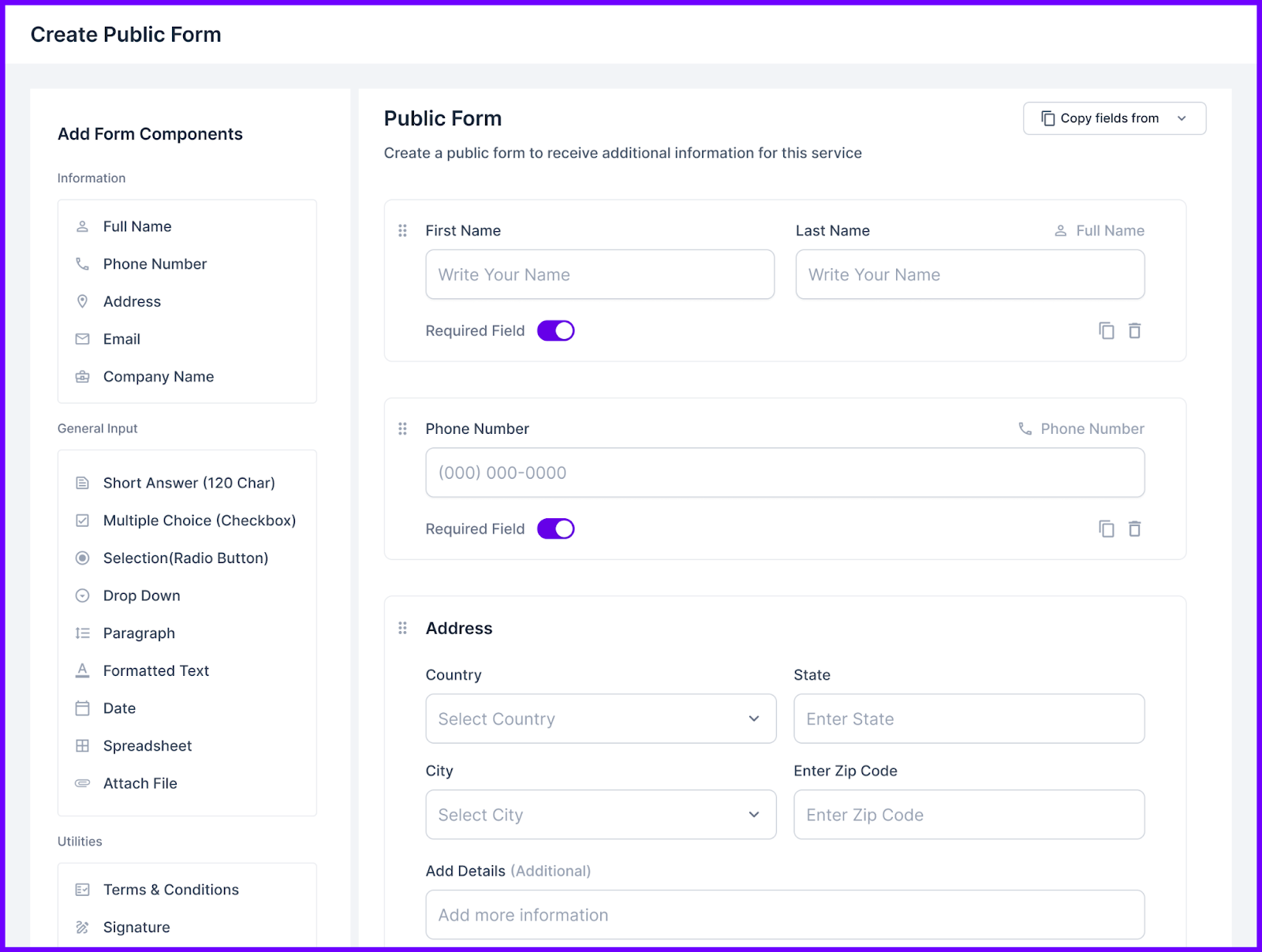
And eventually, manage leads through the CRM to control the lead funnel and convert them into clients.
What are the Stages of the Client Acquisition Funnel?
The client acquisition funnel is a step-by-step journey, and understanding each stage is the key to effectively finding and guiding prospects.
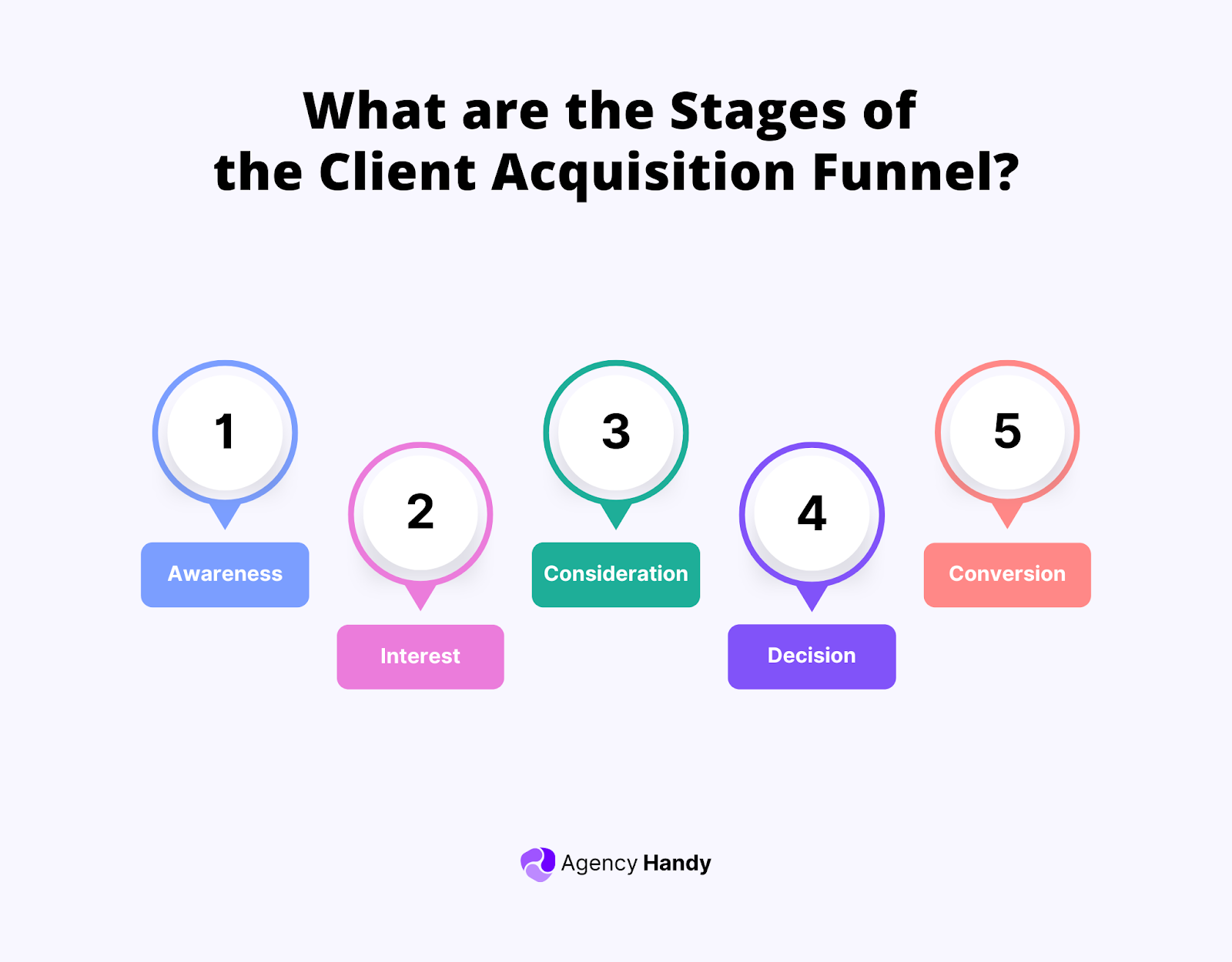
1. Awareness
The first step in the client acquisition process is awareness.
In this stage, potential customers are just learning about your brand and what you offer.
For example, they might see an ad or come across a piece of content that introduces them to your business.
Your goal here is to get on their radar.
At this stage, your marketing efforts should focus on reaching your target audience through digital content marketing, ads, SEO, etc.
Now, with awareness-stage marketing, you can —
- Place ads on search engines and social media to catch eyes fast.
- TV, print, and radio ads remain useful for reaching a large audience.
- Get featured in news articles or interviews to increase trust and visibility.
- Share blog posts, guides, and case studies that help and inform readers.
- Optimize your website so it appears when people search for relevant answers.
2. Interest
Once potential clients are aware of your brand, the interest stage lets them explore what you offer in more detail.
For example, after seeing an ad for client portal software, they might visit your website and download an ebook on productivity tips.
Now, your goal is to nurture their interest by providing —
- Resources like eBooks, blog series, and webinars that explain how your solution actually helps.
- Well-timed, relevant emails that answer questions before they’re asked.
- Calculators, self-assessments, or quick quizzes that show them where they stand and what they can improve.
- Client testimonials, success stories, and honest reviews to show you’re not just talking.
- One-pager or a full comparison page, help them choose with confidence.
3. Consideration
Now, prospects actively decide if your product or service is the right solution for them against your competitors.
But trust is the key here.
That’s why provide extensive product details, real-world examples, and customer feedback to establish credibility. In that case, you can —
- Showcase studies to highlight how you’ve helped real clients solve real problems.
- Allow customers to try your product and see your solution in action. Whether product demos or free trials, this hands-on experience builds trust quickly.
- Provide comparison guides to size up the market. Lay out what makes you different—be clear, visual, and fair.
- Send timely, relevant follow-up emails that answer deeper questions and keep your solution top of mind.
- Help buyers see what they’ll pay and what they’ll get through cost calculators.
- Share customer testimonials as their voices often carry more weight than your sales pitch.
- Host events where buyers can ask questions and see your expertise up close.
- Run remarketing campaigns that focus on pain points, product strengths, or decision-stage CTAs.
4. Decision
Now’s the moment when your lead is warm.
They’ve looked around, compared a few options, and you’re one of the last names on their list. They’re not browsing anymore. They’re about to choose.
Maybe they’re torn between your agency and another with a similar pitch. This is where you step in with confidence and clarity.
Your job? Help them make that final call.
So, here are a few ways you can help them decide:
- Offer a solid deal, maybe a limited-time discount or a bonus that sweetens the offer.
- Run focused ads that speak directly to their pain points or goals.
- Reach out personally, like a quick check-in from your sales team, can clear up last-minute doubts.
- Make the sign-up or purchase process smooth, fast, and stress-free.
5. Conversion
The lead has completed the journey, checked out their options, and is about to become your next client.
Maybe they’re sitting on your pricing page. Maybe they’ve started a trial. Either way, they’re leaning in.
Some of the most effective conversion tactics include —
- Clean, distraction-free checkout experiences
- Clear and direct CTAs like “Buy Now” or “Start Free Trial”
- Incentives such as limited-time offers or bonuses
- Quick load speeds and multiple payment options
Finally, don’t overcomplicate it. Make it dead simple for them to take action.
Here, Agency Handy helps you build tidy, adjustable order forms. You can enable fast one-click payments through PayPal, Stripe, Wise, or bank transfers, all without losing your brand identity.
Why is Client Acquisition Important?
The client acquisition process is key for your business to grow and stay successful. So, here’s why it matters so much —
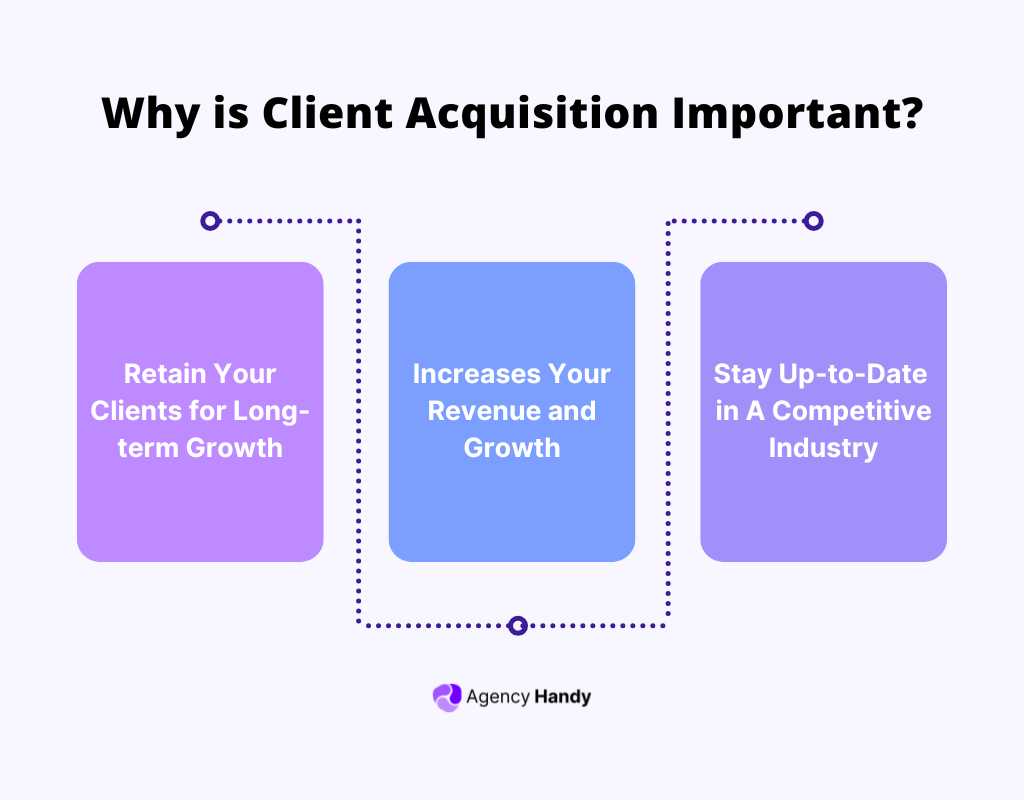
Retain Your Clients for Long-term Growth
Client retention is just as important as finding new ones. To succeed, you need to know why they stop buying from you.
So, take time to learn the reasons behind their exit decisions. Also, ask your previous clients for honest feedback about your products and services.
Do they usually leave due to issues like —
- Complex onboarding experiences?
- Low-quality reporting and analytics?
- A shift in their business goals?
If client onboarding is complex, improve the experience with a crystal clear process. Again, deliver clear and insightful reports if your clients complain about weak reporting.
Moreover, you need to adjust your packages or use targeted emails to bring past customers back, if and when priorities change.
Increases Your Revenue and Growth
Bringing in new paying clients directly increases your business growth.
Simply put, acquiring more clients speeds up revenue and creates stability. To do this effectively, pick digital marketing channels carefully.
Also, test multiple channels, compare their performance, and identify which options produce the most conversions. With Agency Handy’s built-in reporting and analytics dashboard, you can easily track client activity and revenue to double down on what works.
If you can make wise choices here, it’ll lead to quicker growth and a healthier business.
Stay Up-to-Date in A Competitive Industry
Without a solid client acquisition strategy, your business risks falling behind. The marketing world moves fast.
Just a few years ago, customer acquisition tools like webchat were optional extras. But today, they’re central to effective communication.
Similarly, generative AI now shapes marketing content creation and analytics, reshaping the industry at a rapid pace.
So, keeping up with these shifts matters for your agency’s survival. The right client acquisition plan will help you adapt quickly and attract clients who value innovation.
What are the Channels of Client acquisition?
Not all marketing channels deliver the same results. Understanding the best client acquisition channels helps you attract new customers and increase growth without wasting resources.
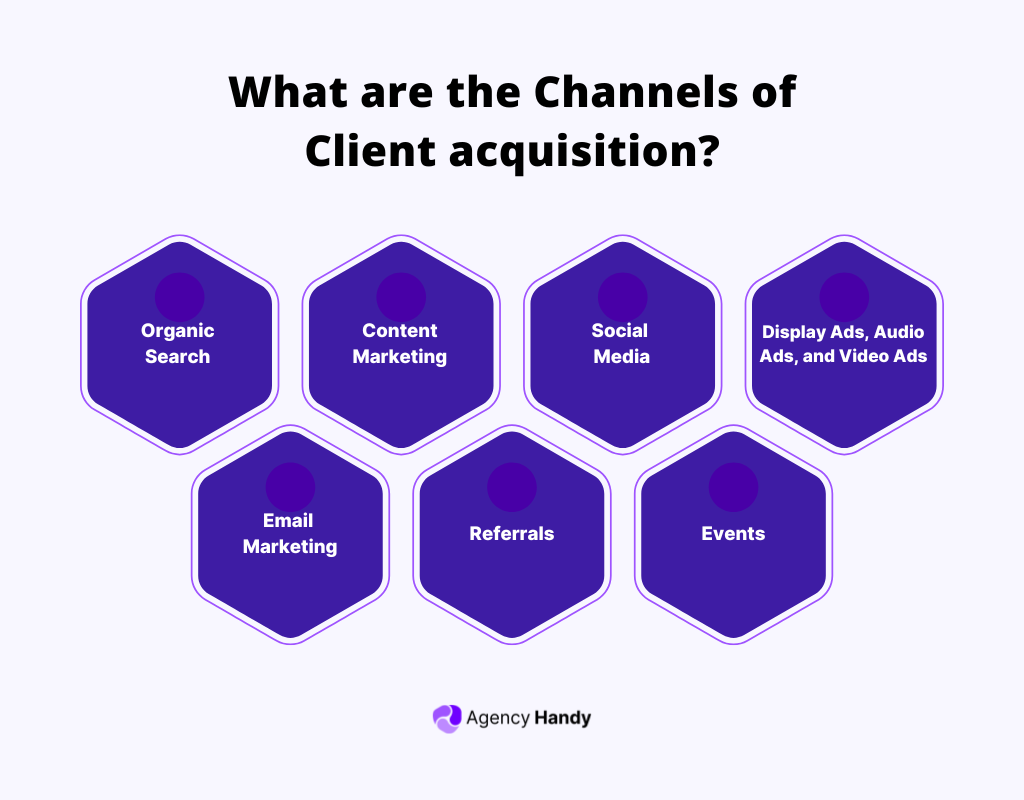
Organic Search
Organic search pulls in the most potential customers who find you naturally on search engines like Google or Bing.
You must appear at the top of search results when people look for information relevant to your products or services.
That’s because, out of all clicks, 68.7% go to the first three organic search results.
That said, according to Bounteous, initial tests show that AI Overview might reduce organic traffic by 18% to 64% for certain websites. It’s especially noticeable for sites that rely on informational searches.
Don’t fret. Instead, make your content search engine-friendly by —
- Create your topical map and choose keywords.
- Following the inverse pyramid content outline.
- Targeting paragraph-based optimization.
- Properly optimize the content with NLP.
- Lastly and most importantly, creating helpful content.
When AI doesn’t know an answer and has access to web searches, it will turn to a search engine. That’s why appearing in search results still matters.
In that case, you can use —
- Semrush, Ahrefs, or Moz to simplify keyword research
- Frase or Surfer SEO for NLP optimization and content outline
Experiment and see exactly how potential customers search online.
Content Marketing
Content marketing helps you attract new audiences by sharing useful, relevant content. The key is creating content that solves real problems and answers genuine questions.
In early 2024, a survey found that nearly 50% of business leaders worldwide intended to increase their spending on content marketing that year.
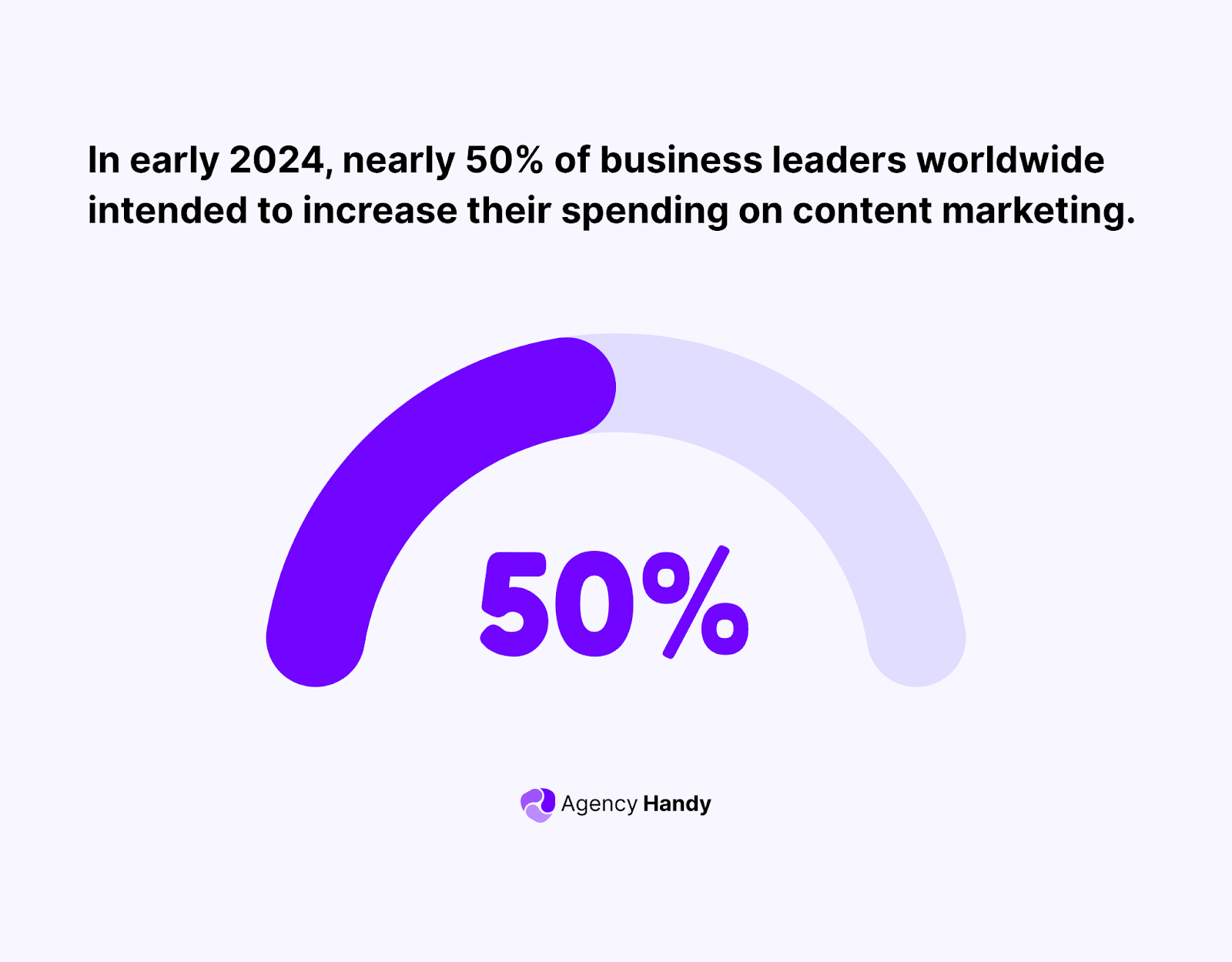
Regarding that, you could publish insightful blogs, create engaging videos, or share downloadable guides and infographics.
Hosting webinars can also help you connect emotionally and intellectually with your audience. Remember, great content builds trust, attracts leads, and gently nudges prospects closer to becoming customers.
Social Media
Social media helps you connect directly with new customers.
And that’s especially true when 90% of people turn to social media to keep track of current trends and cultural events.
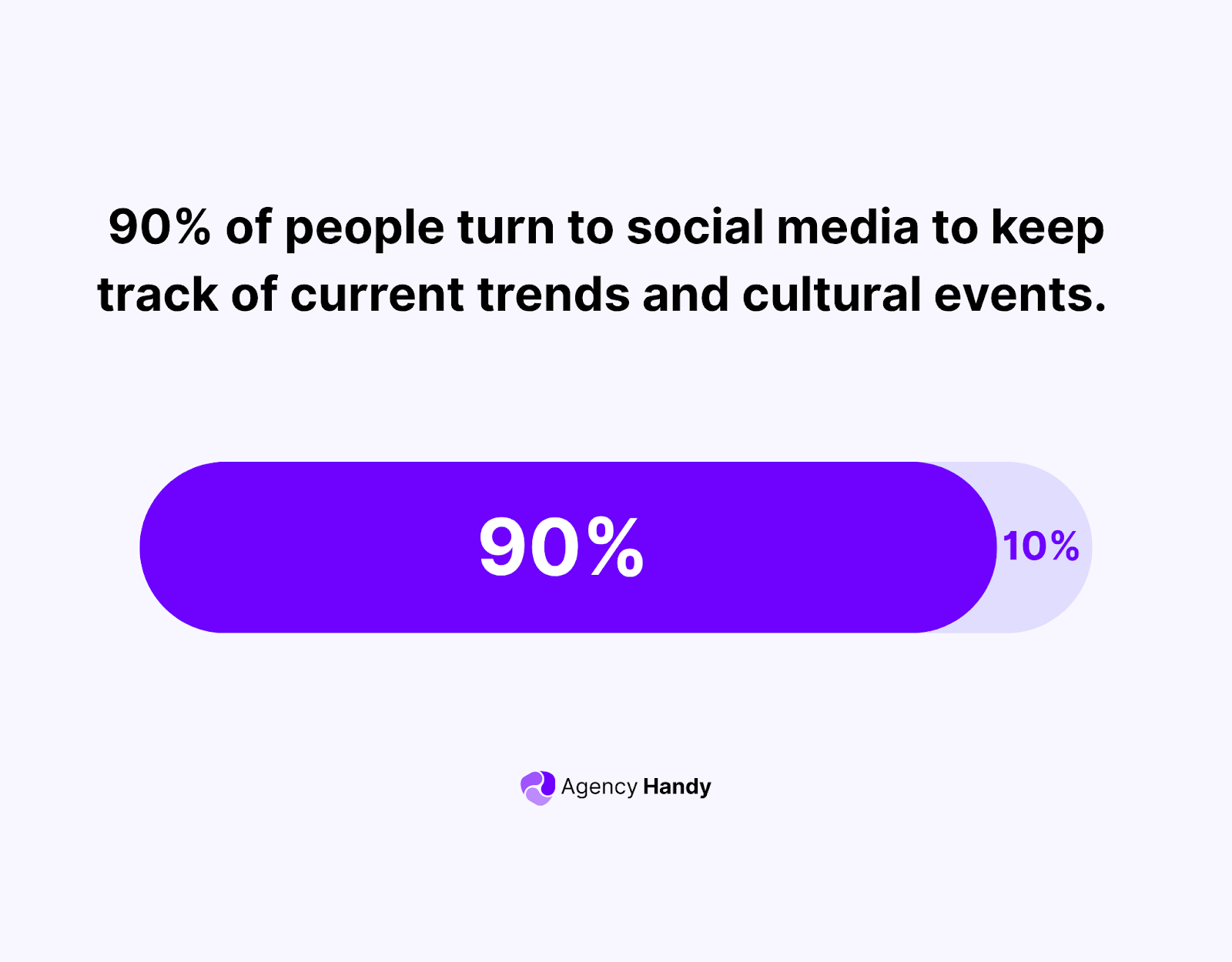
Now, when it comes to social media, you have two options.
- Organic Social Media
Organic social media lets you build relationships without spending money on ads. You can post valuable content, like blogs, videos, and company news, to increase awareness and create interest.
When followers like what you share, they spread the word to their networks. This natural growth helps your brand become known and trusted.
- Paid Social Media
Paid social media means spending money to reach your ideal audience faster.
With paid ads, you can quickly get your content in front of people interested in what you offer. That way, you don’t need to wait for organic growth.
Also, tools like Facebook Lead Ads can help you collect important customer data and turn random visitors into real leads.
So, if you need quick results, paid ads can provide your business with an instant lift.
Display Ads, Audio Ads, and Video Ads
Speaking of paid ads, display, audio, and video advertisements can expand your reach quickly. These ads introduce your brand to people and show what makes it unique.
In 2024, global spending on digital video ads reached over $191.3 billion. As expected, the U.S. led the market, with China and the U.K. coming in second and third place.
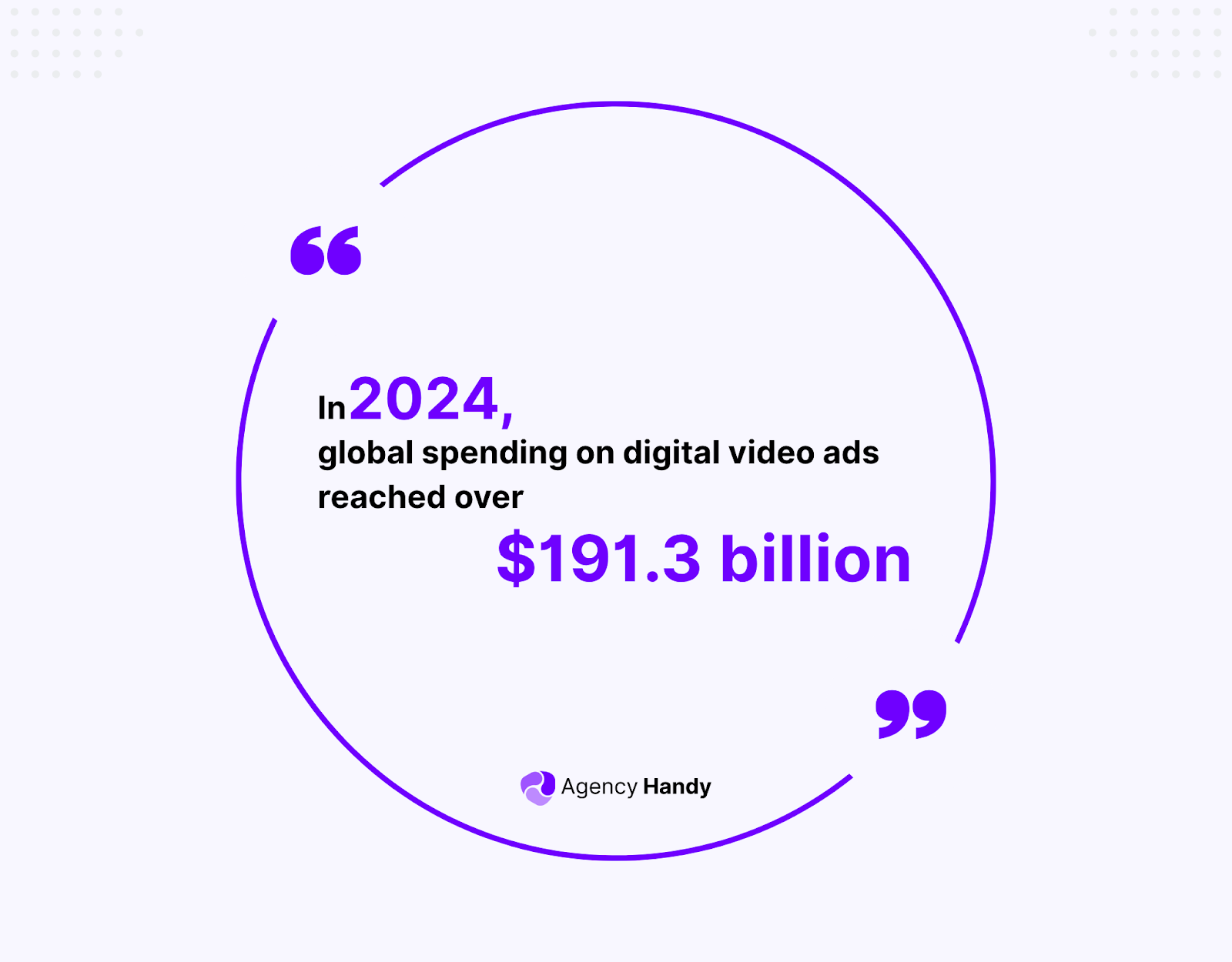
You can also promote special deals or discounts using targeted ads. This method brings potential customers closer to buying. By consistently showing your ads, your business stays on their mind when they’re ready to decide.
Email Marketing
Email marketing lets you communicate directly and personally with potential and current customers. Even though it’s not the newest method, email is highly effective for reaching your audience.
In fact, email is the preferred way for 60% of customers to get messages from brands. That’s great news for you.
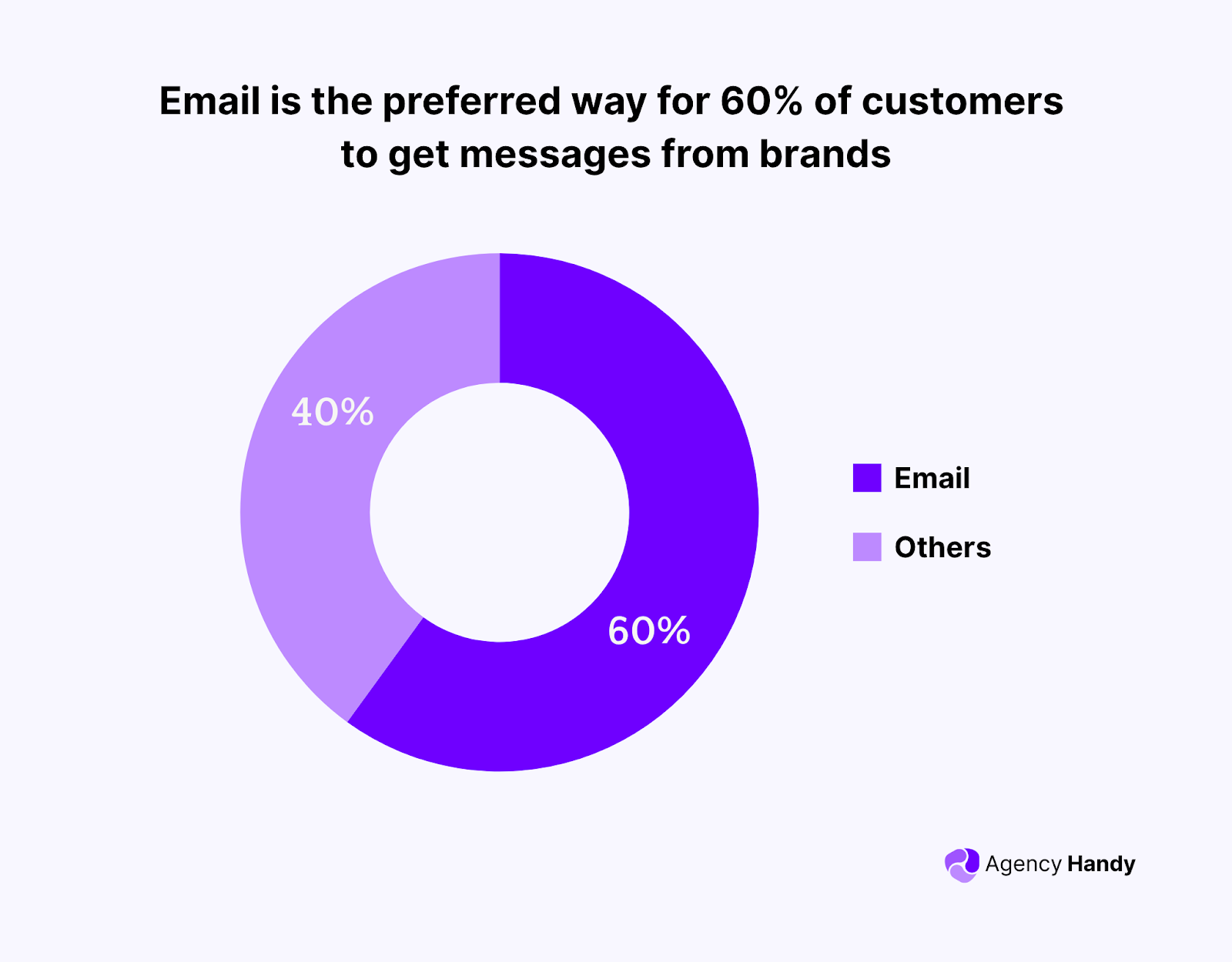
According to InfiniteTwist 9786 (a Reddit user), cold emails bring in 80% of their clients. As a web agency, they focus on sending a lot of emails instead of making each one highly personalized.
In fact, they tested personalized emails, but surprisingly, they didn’t significantly boost replies. Currently, they send emails from roughly 5,000 different inboxes every day.
That said, Agency Handy makes email outreach easy. With adjustable templates and built-in SMTP, you can automate campaigns, customize messages at scale, and manage all communication from a central hub.
Referrals
Getting referrals from satisfied clients is a low-cost way to attract new customers. As they come from a trusted source, referrals carry a lot of weight, making them one of the most impactful ways to expand your client base.
Besides, people over 44 say recommendations from others give them useful details they wouldn’t find on their own. Thus, you should design a well-organized referral program to improve your customer acquisition.
For B2C businesses, incentives often work best, while B2B companies might prefer more direct referral requests.
Events
Events, whether virtual or in-person, are great for connecting with potential clients.
- Virtual Events
Virtual events like webinars and online conferences have become a great way to meet new prospects. They’re easy to attend, and you can connect with potential clients and sponsors from anywhere.
If you’re just starting out, you can host a small webinar or rent a booth at a larger event to test the waters.
- In-person Events
These events still hold strong value for building relationships. When you speak at conferences, it positions your business as a trusted leader in the industry.
Pro Tip: Make sure to get people’s contact details at events. Afterward, send them personalized messages to stay in touch long after the event is over.
Top 11 Client Acquisition Strategies to Bring in More Revenue
Acquiring new customers requires more than just advertising. You need to create experiences that grab attention and build trust.
Here are some client acquisition strategies to help you stand out and turn prospects into loyal clients.
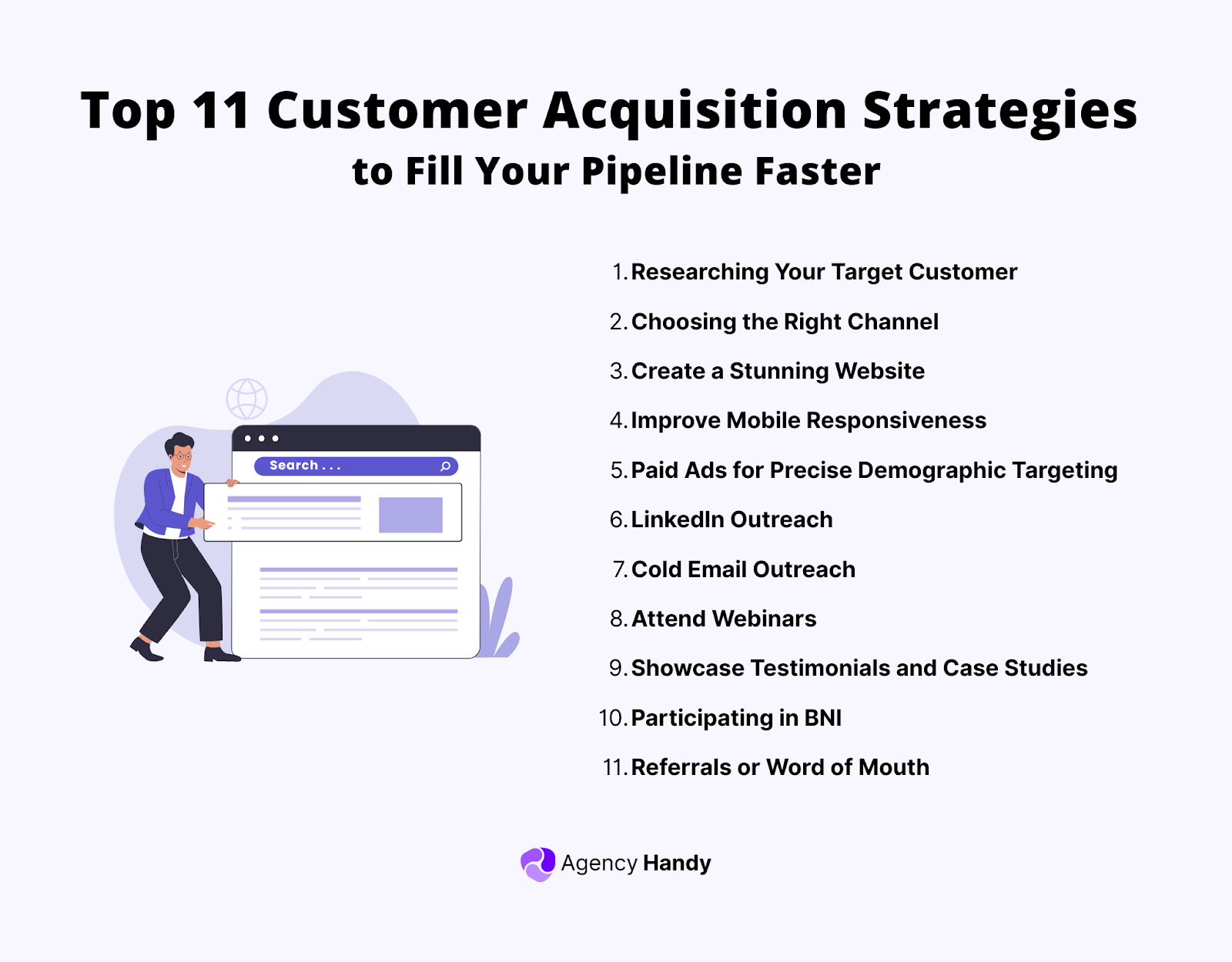
1. Researching Your Target Customer
Before you try to bring in new clients, take time to really understand who they are. Customer research is about figuring out what matters to the people you’re trying to reach
- What are they looking for?
- What’s getting in their way?
- Why do they pick one brand over another?
To begin, get clear on who your ideal clients are. You can —
- Sort them by age, interests, buying habits, or location.
- Then, create ideal customer profiles or “personas” that describe their needs, goals, and pain points.
This helps you see things through their eyes. Now, from there, use tools like heatmaps or session replays to watch
- How visitors interact with your site?
- Where do they click?
- Where do they stop?
- Where do they leave?
Combine that with feedback through quick surveys or polls to learn what’s working and what’s not. Also, talk to real users. Run short interviews or send out questionnaires.
Over time, you’ll start to notice trends, which makes it easier to improve your approach. When you know your audience well, winning their trust becomes a lot easier.
2. Choosing the Right Channel
Once you’re clear on who you want to reach, the next step is finding out where they actually are. Don’t assume every marketing channel will work for you.
Start by figuring out where your audience hangs out. Are they scrolling LinkedIn, checking emails, or searching on Google?
Focus your efforts where they’re most likely to pay attention, not just where you feel comfortable.
It also helps to check in on your competitors.
- What channels are they using regularly?
- What seems to work for them?
- What do they get right?
- Where do they fall short?
You can learn a lot by watching them. Next, look at your budget. Paid ads can eat up your funds fast, while SEO or social posts take longer but cost less.
Match your strategy to what you can realistically afford.
Most importantly, keep testing.
3. Create a Stunning Website
Your website is often the first interaction potential customers have with your brand, so it needs to leave a lasting impression. A clear, minimal design allows visitors to explore your site easily and quickly learn about your products or services.
That’s why your site should be intuitive, mobile-optimized, SEO-friendly, and visually appealing. It should serve both quick shoppers and those who prefer to research before purchasing.
When your website prioritizes the user experience, it builds trust and guides your visitors toward making a purchase.
As mentioned in a 2021 Harvard Business Review piece, companies shouldn’t stop trying to shape customer decisions. However, their efforts are more impactful when focused on the customer.
Rather than treating it as a sales process, they should design it as a purposeful journey.
4. Improve Mobile Responsiveness
A smooth mobile experience is important for customer acquisition. Today, people browse on their phones while on the move, relaxing at home, watching TV, or before bed.
This constant connection creates ample opportunities to engage with your potential customers. However, only if your website is responsive and easy to navigate.
According to a survey, 73.1% of web designers believe that bad, mobile-friendly websites are the top reason users exit a site. When creating your mobile site, focus on keeping it clear and simple.
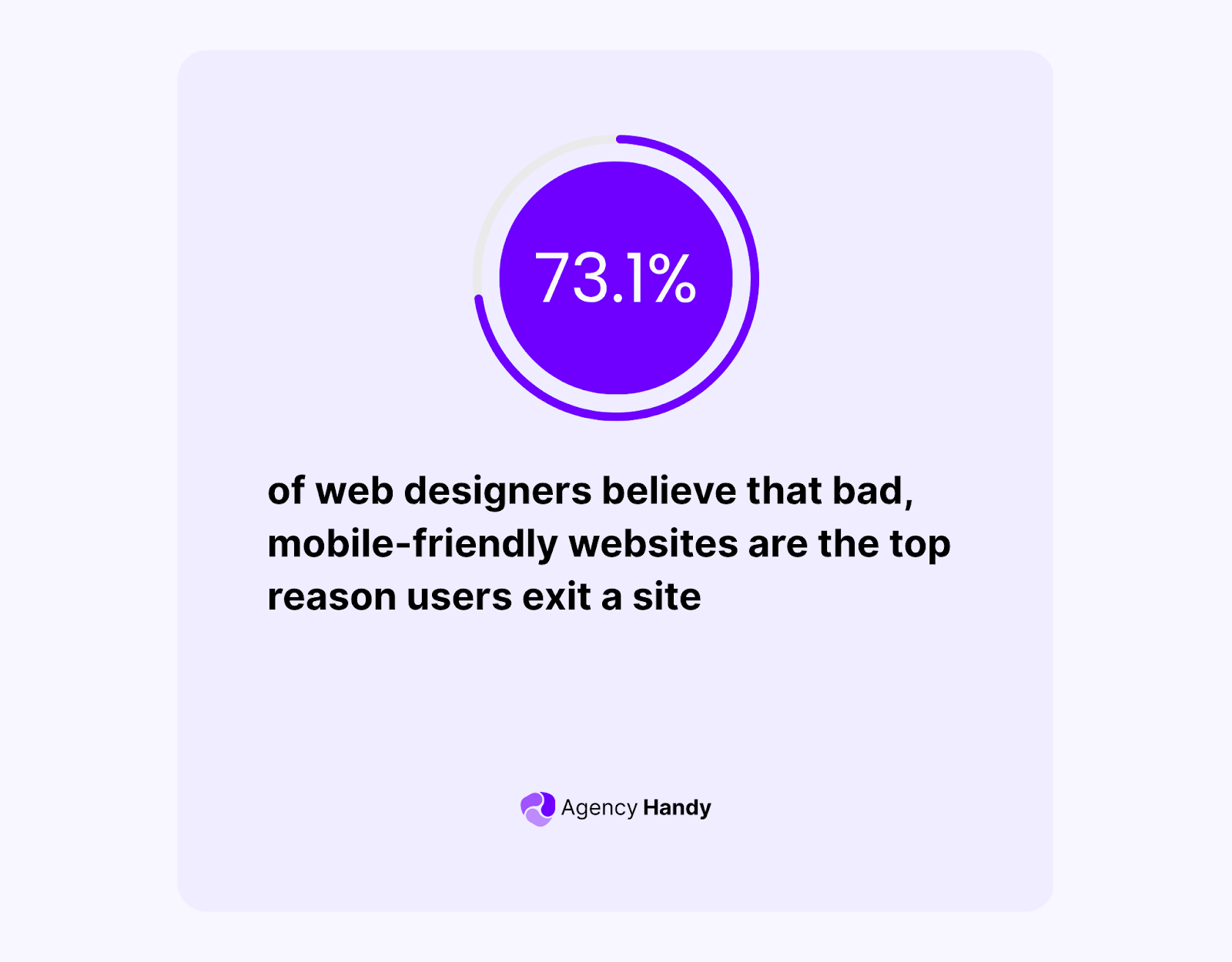
The goal is to be helpful and transparent, not just to push for sales. So, make it easy for visitors to connect with a sales rep, sign up for a trial, or get support if they’re having trouble.
5. Paid Ads for Precise Demographic Targeting
Paid advertising lets you focus on the exact audience that fits your services. You can fine-tune your strategy by using tools like Google Ads and LinkedIn Ads.
- Google Ads
Google Ads helps you showcase your product to potential customers. For example, if your focus is on SEO for SaaS agencies, using keywords like “SEO for SaaS agency” can make your ad appear higher in search results.
A good ad has a short headline (under 30 characters), a clear call-to-action with an attractive offer, and proof of your success in drawing in customers.
- LinkedIn Ads
LinkedIn Ads improve your paid advertising by letting you create highly targeted marketing campaigns. You can reach potential customers by focusing on their job titles, skills, and industries, which is perfect for B2B marketing.
Besides, LinkedIn offers a range of tools like Sponsored Content, Sponsored Messaging, Dynamic Ads, and Text Ads. They ultimately help you bring in quality leads and increase your sales pipeline.
- Social Media Ads
With 5.24 billion people active on social media, it’s one of the best places to reach your future clients. With paid ads, you can place your message directly into their feeds on platforms like Instagram, Facebook, YouTube, and TikTok.
You can choose who sees your ads by interest, behavior, or even keywords. That way, you’re not wasting time on the wrong audience.
Depending on what you want to show, you can also pick from different ad types, like videos, carousels, or collections.
In addition, you can track how everything performs in real time, including clicks, views, and sales. It’s affordable, flexible, and a smart move if you want to grow without overspending.
- PPC Ads
Pay-per-click (PPC) ads help you appear right when someone’s searching. Now, the best part is you only pay when they actually click.
These ads can show up on search engines like Google, or on social platforms like Facebook, Twitter, and Microsoft Ads.
Here’s what you do —
- Pick a few keywords
- Set your budget
- Write your ad
When someone types in those keywords, a quick auction decides whose ad gets shown. Also, you’ll need a clear, useful ad and a solid landing page to stand out.
Moreover, PPC ads give you control the whole time. You set how much you want to spend, who sees your ads, and when they appear. When done right, PPC lets you reach the right people at the right moment
6. LinkedIn Outreach
LinkedIn is an excellent resource for client acquisition, thanks to its extensive professional community. For better results, create personalized outreach that highlights common connections or achievements to create immediate trust.
Reddit users have found success by sending personalized messages on platforms like LinkedIn and Instagram. What’s more, one user even saw great results by sharing personalized video messages.
To stay ahead, regularly update your profile and stay involved by posting relevant updates and joining group conversations. This regular activity helps you gain trust and establishes you as an expert, which can draw in more clients over time.
7. Cold Email Outreach
Cold email outreach effectively acquires new clients by targeting potential customers who can benefit from specific services.
McKinsey & Company’s recent study shows that email is almost 40 times more effective in bringing in new customers than other strategies.
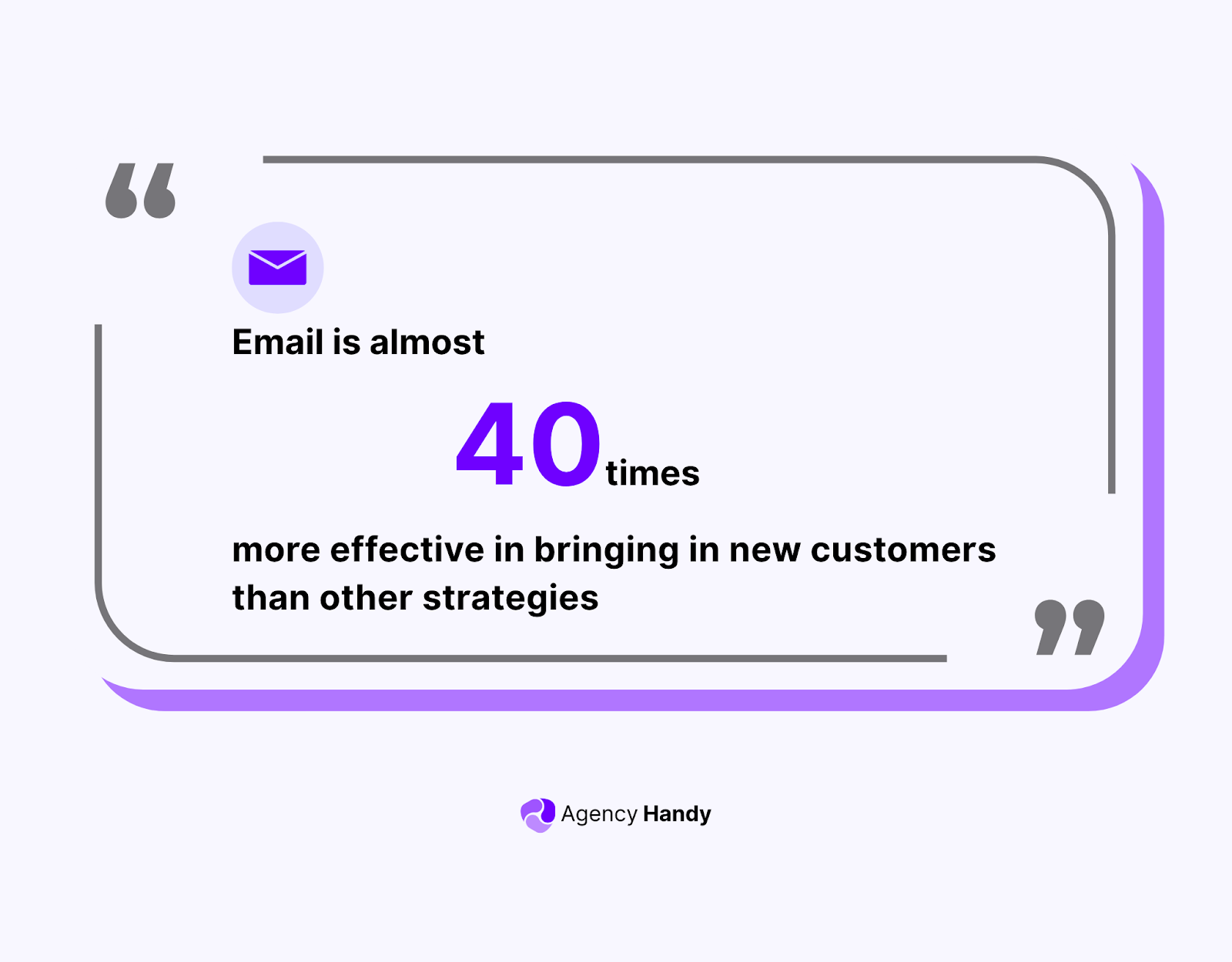
That said, you must be careful with subject lines and clear call-to-action. That’s because a study by Yes Lifecycle Marketing found that cold emails with personalized subject lines get opened 50% more often than those without.

Remember, a targeted campaign produces clear outcomes for the right people, effectively turning potential customers into loyal clients.
This simple method ensures your message gets to the right audience when it matters most.
Eventually, it increases conversions and brings in quality leads for your sales process.
8. Attend Webinars
Webinars are an excellent way to attract potential customers by sharing useful information and interacting directly with your audience.
When you host webinars, you can show your expertise and explain how your services solve problems,
During a webinar, you should focus on delivering content that solves particular customer pain points and highlights your skills. You establish your business as a leading expert in your area by offering real-world solutions during these events.
You can also add interactive Q&A sessions to create a personal bond with your audience. It’ll increase the chances of turning them into clients.
9. Showcase Testimonials and Case Studies
Sharing client stories and testimonials is a great way to attract new customers. It shows your agency’s skills and the real results your clients have achieved.
Here are some simple ways to make the most of these stories —
- Add a section to your website: Create a page like “Client Success” or “Our Results” to showcase these stories clearly.
- Use them in sales materials: Include detailed case studies in your proposals to prove your expertise.
- Add them to emails: Put a short, strong testimonial in your outreach emails to make them more trustworthy and personal.
- Make presentations in webinars: To get an extra edge, talk about your most successful client stories when attending webinars and events.
- Post on social media: Regularly share testimonials or case study highlights using eye-catching images or short videos.
- Offer downloadable content: To generate leads, turn full case studies into PDFs that visitors can download from your website.
10. Participating in BNI (Business Network International)
BNI offers a structured way to grow your business by connecting with others.
As a local BNI chapter member, you’ll be part of a group where everyone is eager to share referrals. This setup helps you grow your network and gain credibility through trusted recommendations.
When you attend regular meetings, it helps to keep your company visible, which often helps in B2B client acquisition.
11. Referrals or Word of Mouth
Referrals and word-of-mouth are trusted ways to bring new clients because they rely on personal recommendations.
When your clients or colleagues share positive experiences, their testimonials act as excellent proof. So, it’s easier for others to trust you.
Those who join through referrals are often more committed and easier to connect with. That’s because they’ve been convinced by the genuine feedback of people they trust. In fact, studies confirm this!
The 2021 Nielsen Trust in Advertising Study found that 88% of people globally value recommendations from friends and family more than other advertising methods.
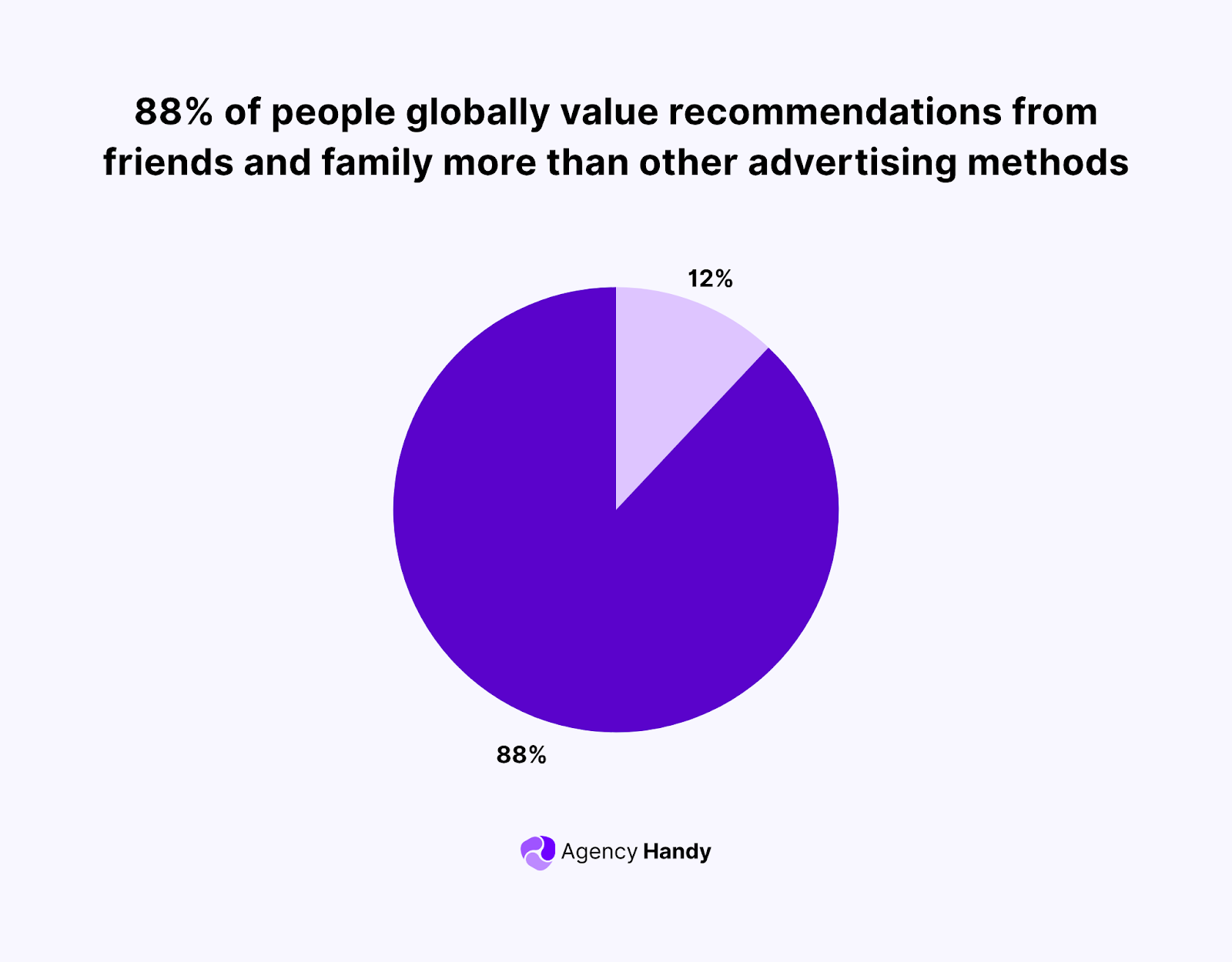
Proven Examples of Client Acquisition
Sometimes, seeing it in action is the best way to understand what works. Here’s how successful businesses and marketers are growing their customer base.
1. Tesla: Referral Program to Increase New Sales
Tesla’s referral program motivated customers to advocate for the brand. Both the referrer and the new customer received a $1,000 bonus credit, helping Tesla grow sales.
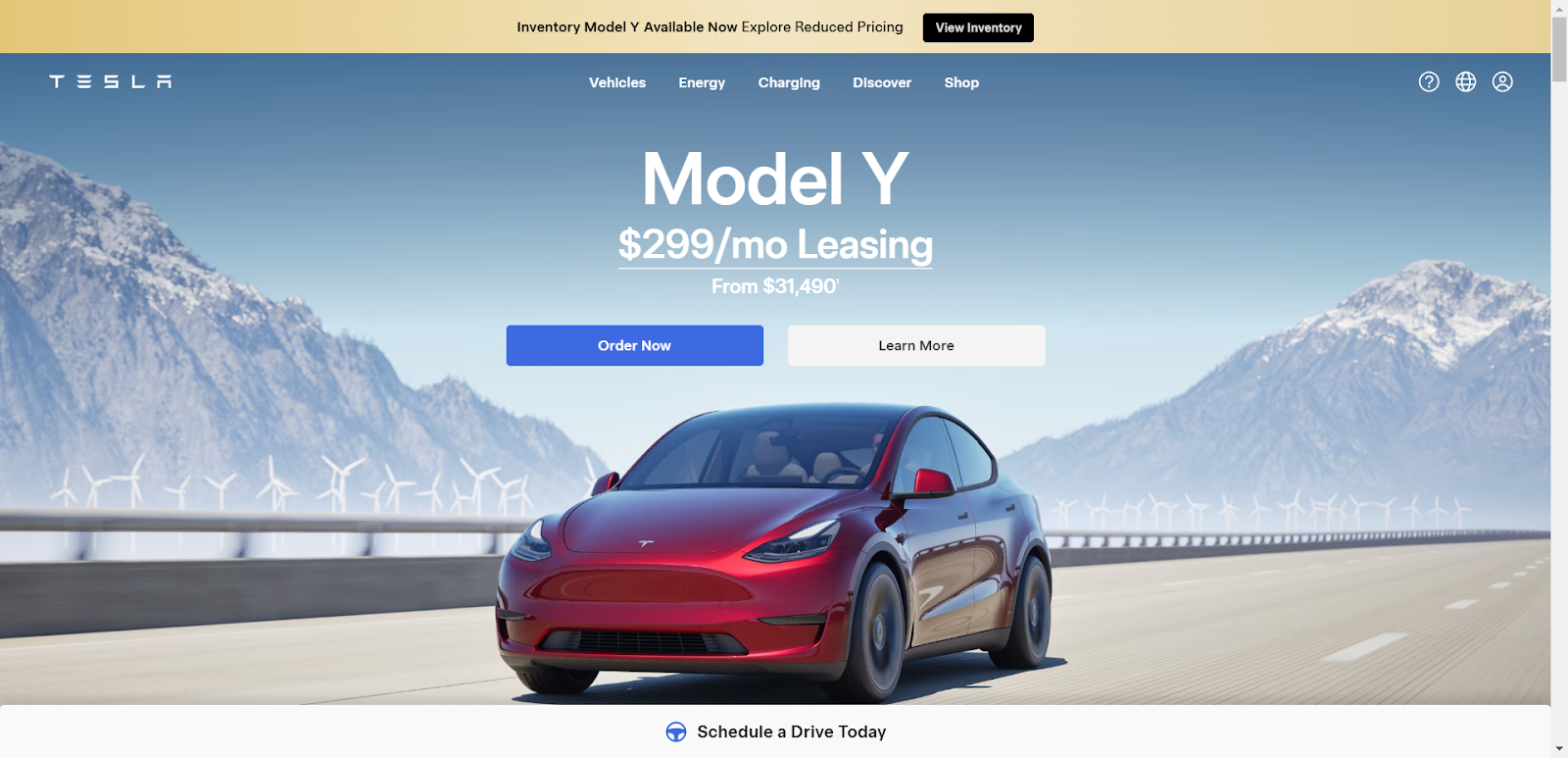
Moreover, top performers earned exceptional rewards, including access to exclusive events and premium Tesla vehicles.
The success of Tesla’s referral program was evident in its impressive ROI. For instance, a participant named Andy received a $500,000 Founder Series Roadster for successfully referring new customers.
Andy’s referrals resulted in 1,265 Tesla purchases, mainly of the Model 3, which brought in roughly $44 million. Therefore, for every dollar Tesla spent on rewards, it earned approximately $88 in sales.
2. Sephora: Loyalty Rewards to Win Clients
Sephora’s Beauty Insider program is a smart way to turn new buyers into regular customers. It’s free to join and has three levels —
- Insider
- VIB (spend $350 per year)
- Rouge (spend $1,000 per year)
The more you spend, the more you unlock, like —
- Early access to new drops
- Free two-day shipping
- Makeovers
- Invites to exclusive events
What makes it stand out is the personal feel. You get personalized product suggestions, birthday gifts, and rewards through the app. You can use your points for discounts or donate them to a cause.
3. Lululemon: Winning Clients Through Community
Lululemon’s success is built on people. From 2022 to 2023, their revenue grew by 19%, reaching $9.6 billion.
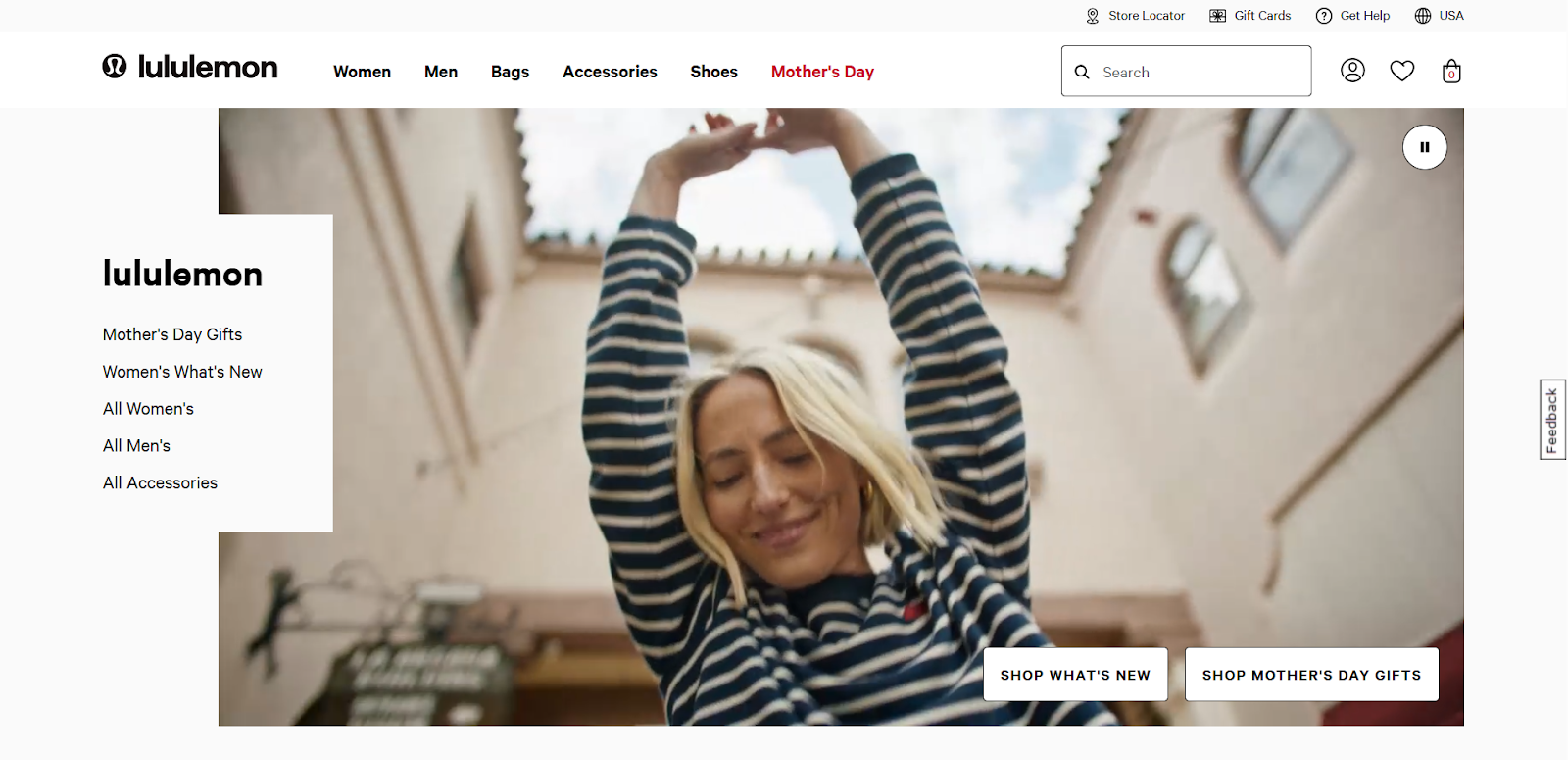
What’s driving that growth? A strong focus on community.
They’ve built loyalty through programs like the —
- Sweat Collective
- Ambassador Network
- Lululemon Collective
Here, customers become part of the brand’s story. These groups help promote the brand while staying connected through events and shared values.
One standout example is the Lululemon Further event. Ten women ran more than 2,800 miles in six days. Lululemon supported them with custom gear and later used those designs to inspire future releases.
How Do You Measure Client Acquisition?
Here are the core customer acquisition metrics you can use to analyze the effectiveness and cost of client acquisition.
Customer Acquisition Cost (CAC)
This metric, known as CAC, represents the total expenses related to acquiring a new customer. It helps you find out client acquisition costs.
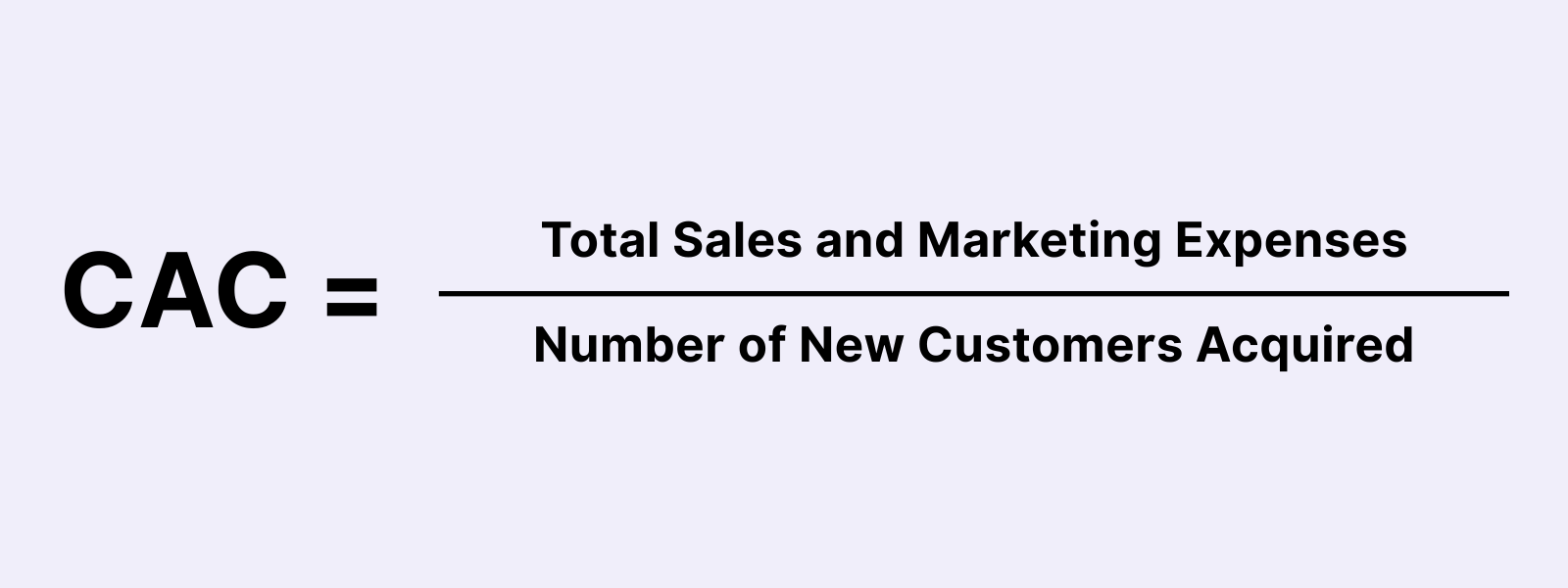
CAC = (Total Sales and Marketing Expenses) / (Number of New Customers Acquired)
Example Equation for CAC
Suppose you spent $5,000 on sales and marketing in one month. During that same month, you acquired 25 new customers.
Now, using the formula —
- CAC = Total Sales and Marketing Expenses/Number of New Customers Acquired
- CAC = $5,000/25
So, your Customer Acquisition Cost (CAC) is $200.
Customer Lifetime Value (CLV or CLTV)
CLV forecasts the overall revenue a business can expect from a single customer throughout their relationship.
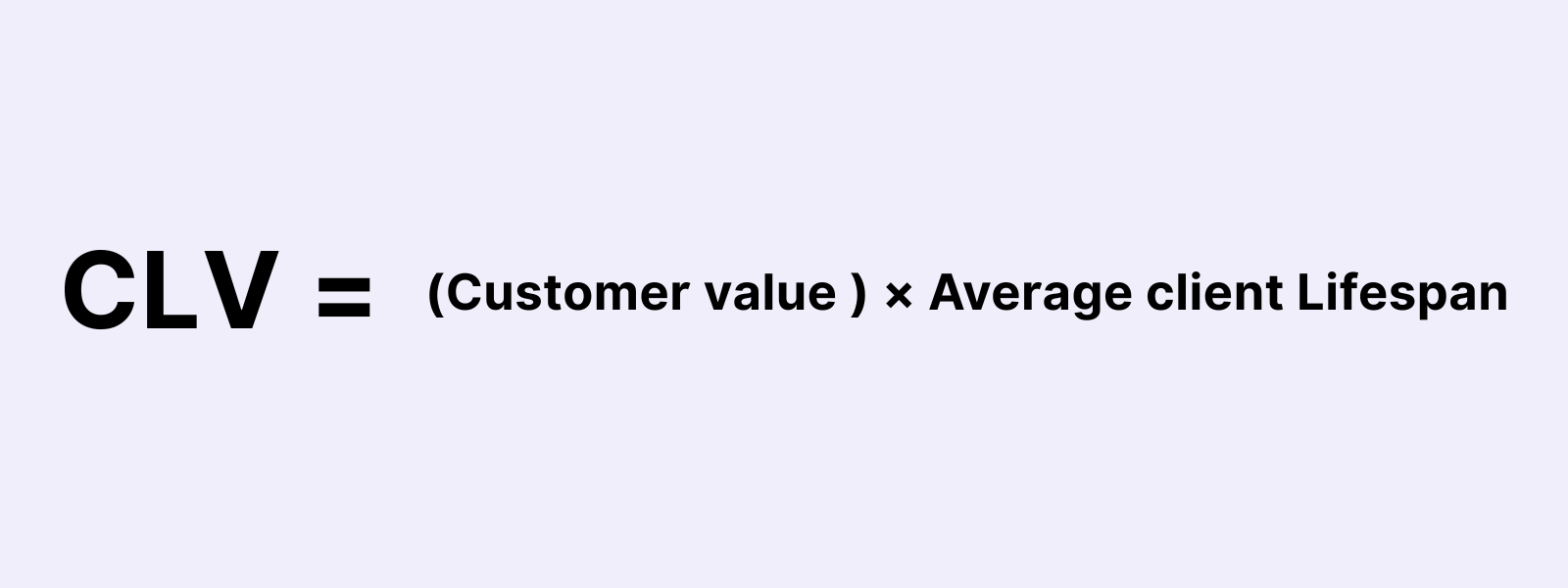
Customer lifetime value = (customer value * average customer lifespan)
Example Equation for Customer Lifetime Value (CLV)
Take your average customer who spends $500 per year with your business. On average, a customer stays with you for 4 years.
Now, using the formula —
- CLV = Customer Value × Average Customer Lifespan
- CLV = $500 × 4
So, your Customer Lifetime Value (CLV) is $2,000.
Conversion Rate
This rate measures the number of leads that complete a desired action, such as a purchase.
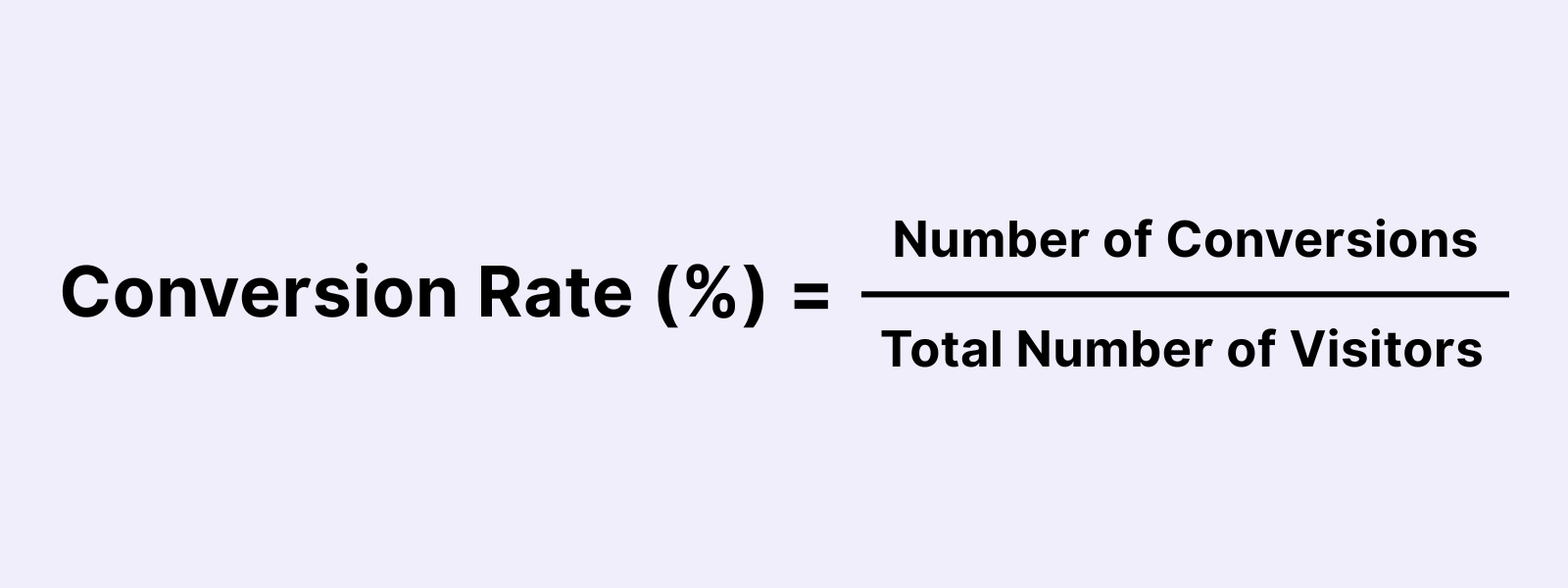
Conversion Rate (%) = Number of Conversions ÷ Total Number of Visitors
Example Equation for Conversion Rate (%)
For instance, your website had 2,000 visitors in one month. During that same month, you gained 150 conversions (such as purchases, sign-ups, or inquiries).
Now, using the formula —
- Conversion Rate (%) = Number of Conversions ÷ Total Number of Visitors
- Conversion Rate (%) = 150 ÷ 2,000
- Conversion Rate (%) = 0.075 or 7.5%
So, your Conversion Rate is 7.5%.
Gross Margin
This margin is what remains from your sales revenue after covering the direct expenses like production costs.
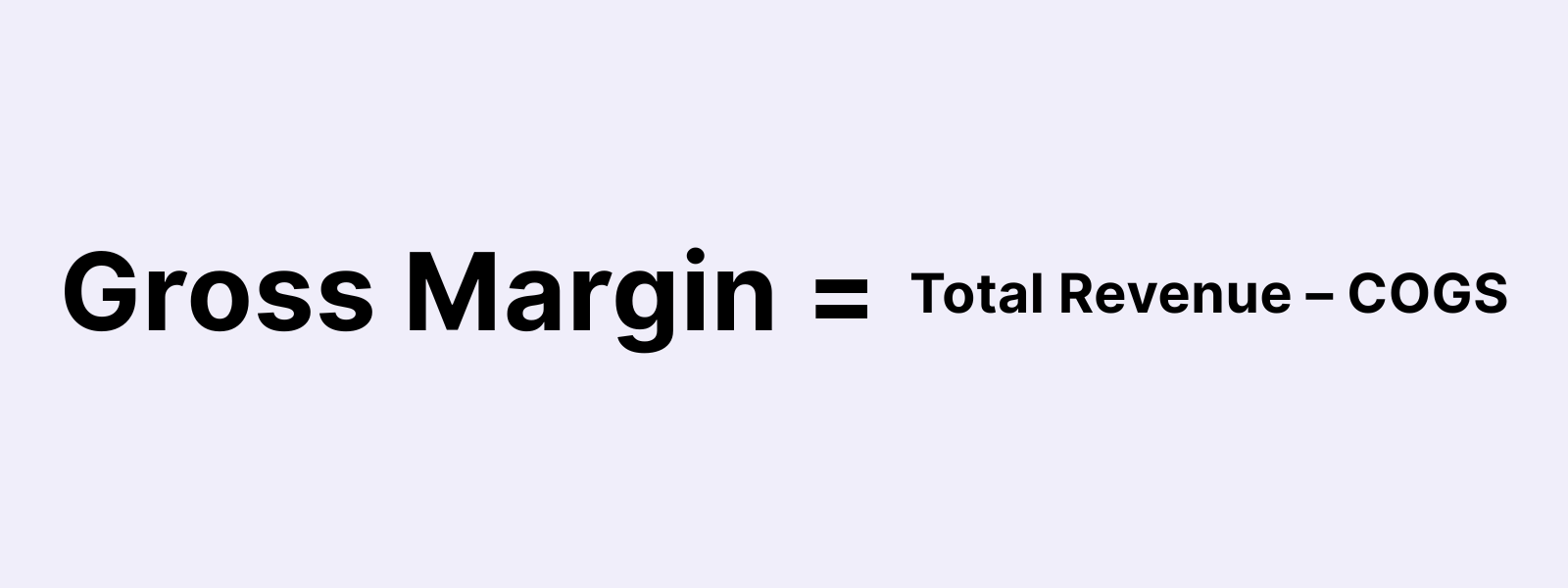
Gross Margin = Total Revenue – COGS
Example Equation for Gross Margin
Suppose your business generated $20,000 in total revenue last month. During that same month, your Cost of Goods Sold (COGS) was $8,000.
Now, using the formula —
- Gross Margin = Total Revenue – COGS
- Gross Margin = $20,000 – $8,000
So, your Gross Margin is $12,000.
Landed Cost Margin Landed
Its costs include all variable expenses required to complete an order.
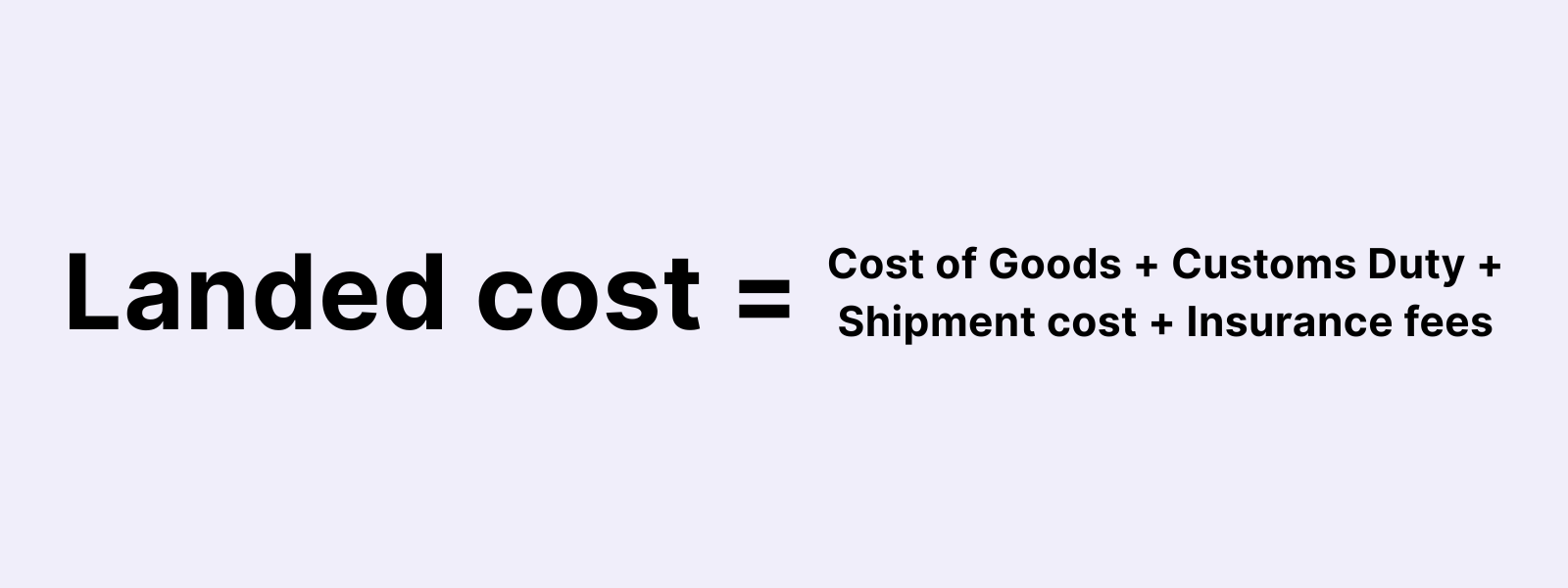
Landed cost = Cost of Goods + Customs Duty + Shipment cost + Insurance fees
Example Equation for Landed Cost
Consider you purchased goods worth $2,000. You also paid $300 in customs duty, $500 for shipment costs, and $200 for insurance fees.
Now, using the formula —
- Landed Cost = Cost of Goods + Customs Duty + Shipment Cost + Insurance Fees
- Landed Cost = $2,000 + $300 + $500 + $200
So, your Landed Cost is $3,000.
Churn Rate
The Churn Rate shows the percentage of customers who stop doing business with a company over a certain period.
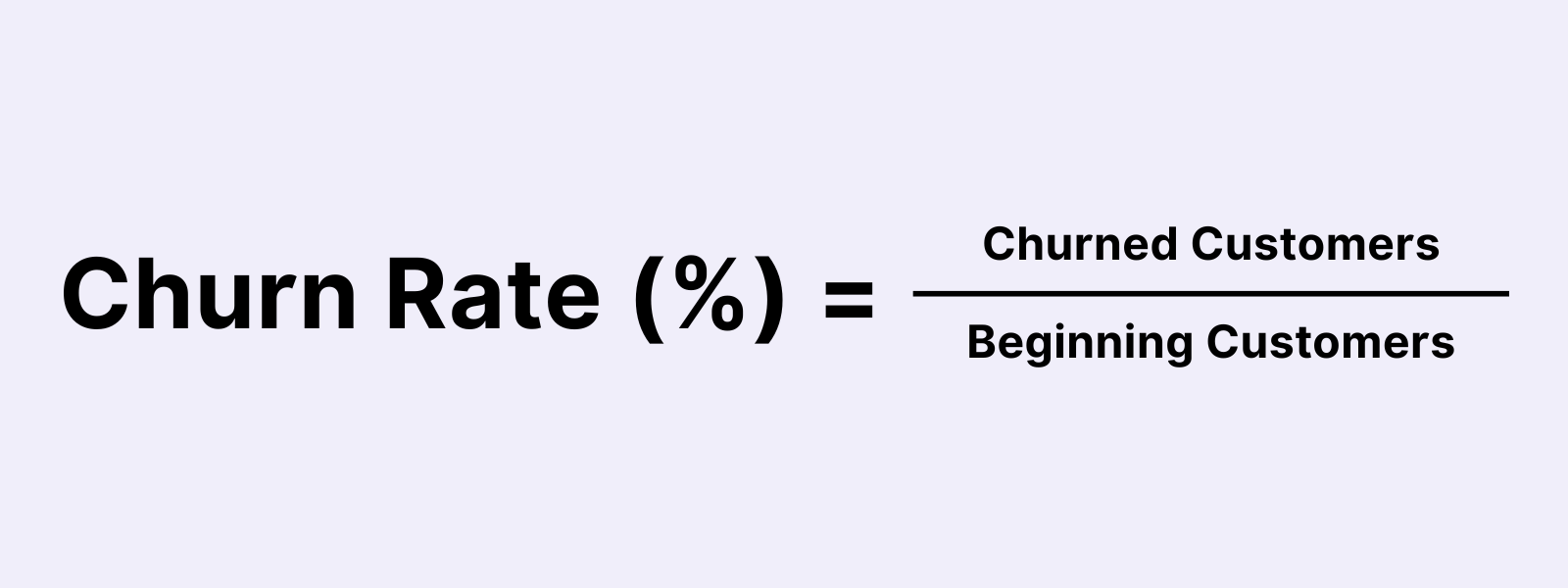
Churn Rate (%) = Churned Customers ÷ Beginning Customers
Example Equation for Churn Rate (%)
Suppose you started the month with 200 customers. During that month, 20 customers canceled their subscriptions or stopped using your service.
Now, using the formula —
- Churn Rate (%) = Churned Customers ÷ Beginning Customers
- Churn Rate (%) = 20 ÷ 200
So, your Churn Rate is 0.10 or 10%.
Common Mistakes You Should Avoid in Client Acquisition
When crafting a growth marketing strategy, client acquisition is pivotal. However, several typical errors can significantly dampen its success. Here’s what to steer clear of —
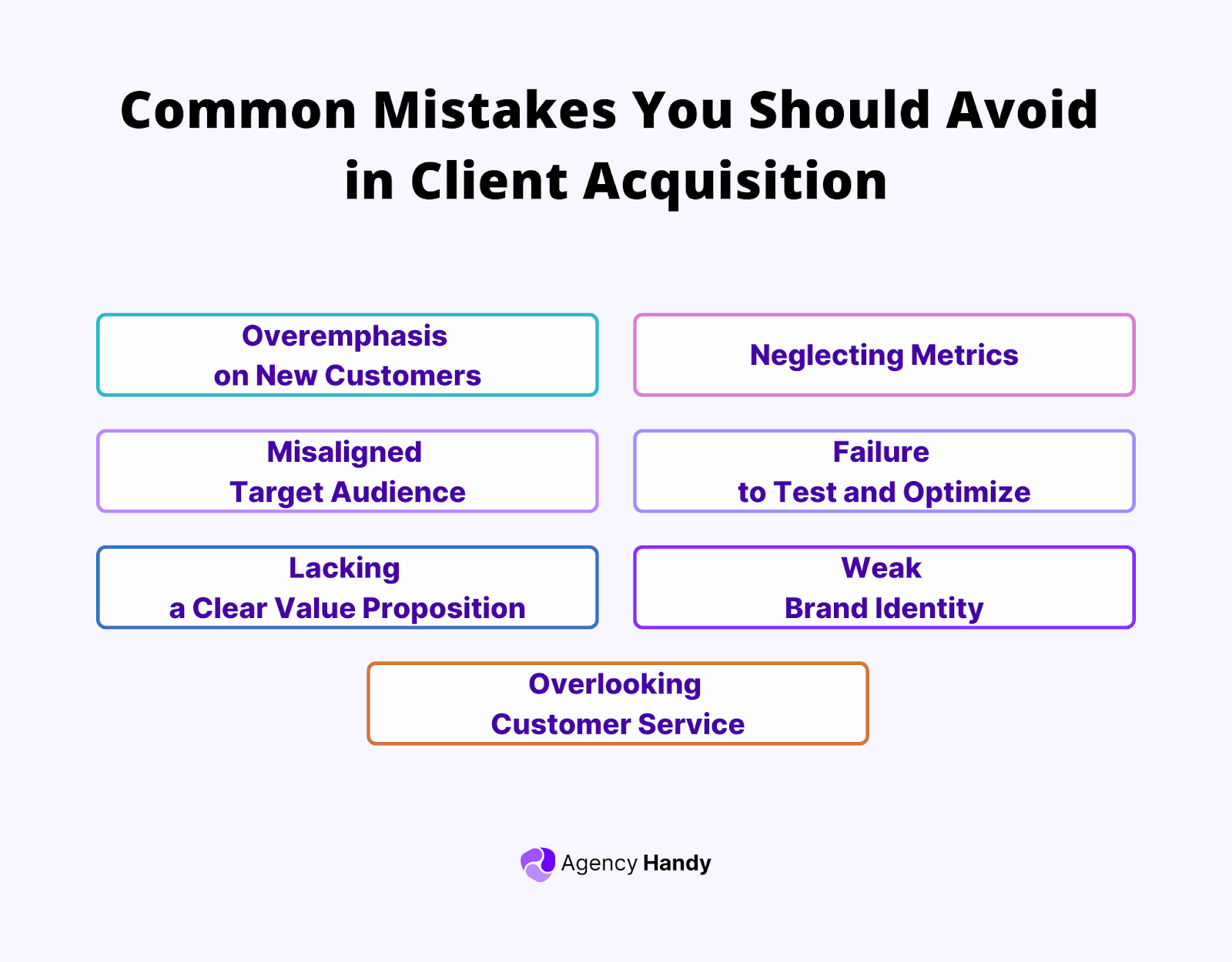
- Overemphasis on New Customers: You must focus on keeping your existing clients while focusing on getting new ones. It’s important to balance acquisition with retention for a stable customer base.
- Neglecting Metrics: To truly understand the impact of your acquisition efforts, it’s vital to track relevant metrics. This data helps refine your strategies and ensure you’re investing in the right areas.
- Misaligned Target Audience: It’s important to know who your ideal customers are and adjust your strategies to reach them. If you don’t, you risk wasting resources on methods that aren’t effective.
- Failure to Test and Optimize: Acquiring customers should be an adaptive process, involving continual testing and refinement. Without this, your business might miss growth opportunities and fail to progress.
- Lacking a Clear Value Proposition: Customers need to see what makes your business better than the rest. A clear and interesting reason to choose you is key to drawing in new customers.
- Weak Brand Identity: A solid brand helps you stand apart from competitors and build a loyal following. If you don’t focus on developing your brand, it can make it much harder to attract new clients.
- Overlooking Customer Service: High-quality customer service is essential for retaining existing customers and bringing in new ones. If your service is poor, it can lead to bad reviews that damage your business’s image.
Best Practices for Customer Acquisition
These are some useful best practices you can follow —
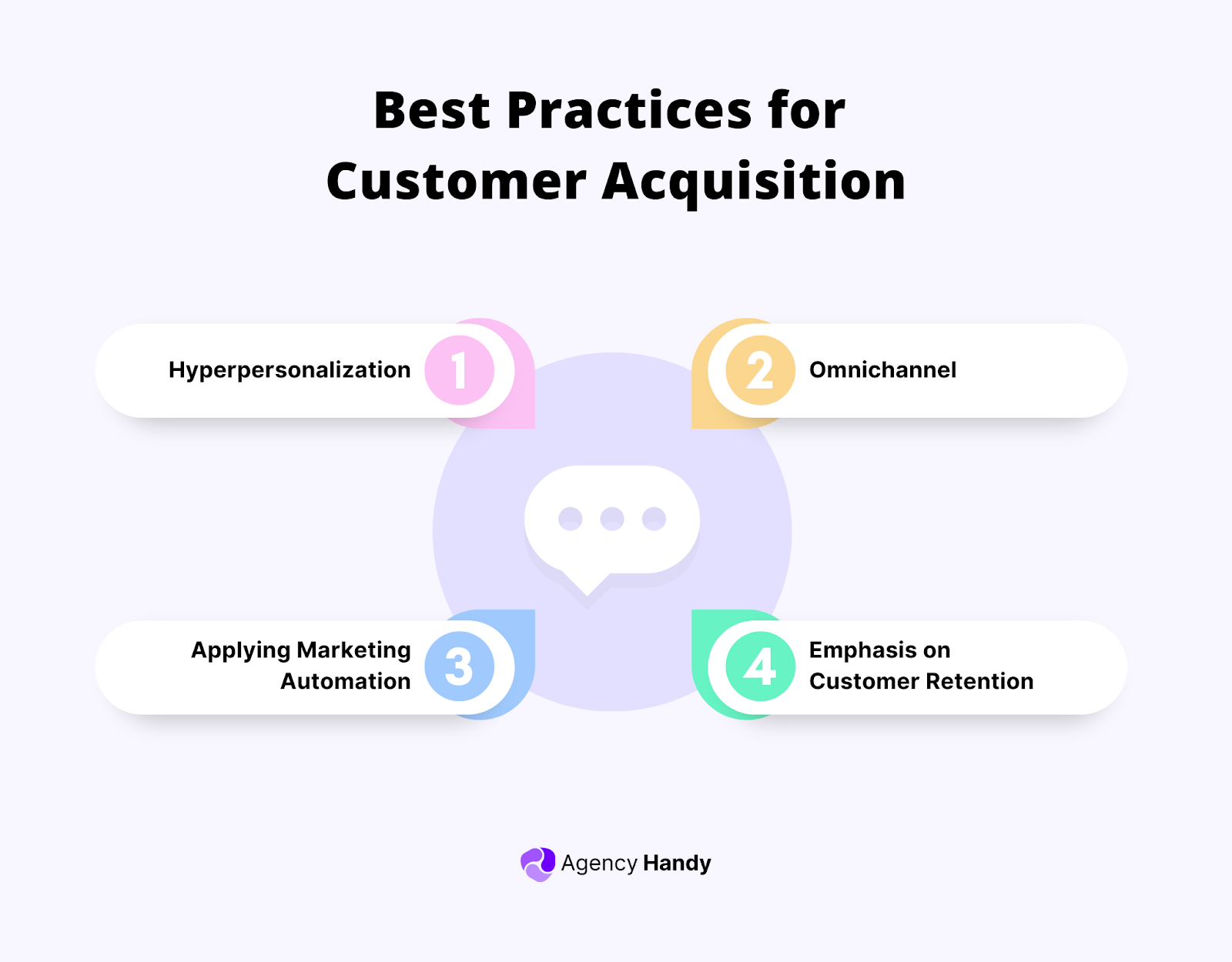
Hyperpersonalization
Hyperpersonalization, which sends highly relevant messages, can help you attract customers more effectively.
Netflix does a great job at personalizing its service. By tracking your viewing habits, search history, and device usage, it adjusts the homepage and suggests relevant content. This way, it keeps users hooked and coming back for more.
Through A/B testing, which can involve up to 100,000 users per test, Netflix ensures every viewer gets a personalized and optimized experience. It shows why hyperpersonalization is such a strong tool for gaining and keeping clients.
Omnichannel
An omnichannel strategy helps customers have smooth and consistent experiences across all platforms. This method is essential now, as people regularly use multiple devices and platforms.
To create a strong omnichannel strategy for attracting customers, companies often use a central CRM system. It helps keep your customer information the same across all platforms.
They also run coordinated marketing efforts that include personalized emails, social media, and customized landing pages.
Applying Marketing Automation
Right now, businesses use marketing automation mainly for email campaigns (63%), social media (50%), and paid advertising (40%). These are the top three areas reported. So, you should too!
Here’s how to use it to attract clients without feeling stressed —
- Prioritize Automation: Figure out which tasks should be automated, prioritize them based on importance and cost, and work on the ones that offer the most value.
- Select the Right Tools: Choose automation tools that can handle multiple tasks simultaneously to simplify integration and maximize efficiency.
- Train and Adapt: Offer tailored training for each team (like CRM processes for sales or email tools for marketing). Also, regularly review and improve your automation plans to ensure they work effectively.
Emphasis on Customer Retention
Holding onto customers matters as much as attracting new ones.
By emphasizing retention, you increase the value of each customer and cut down on the expenses of acquiring others. In fact, if you keep 5% more customers, your profits can grow by over 25%.
Besides, proactive customer support helps you identify and solve problems early, preventing inconvenience for customers. Building lasting relationships through personalized communication, special deals, and regular contact is also key.
When your customers feel valued and have good experiences, they’re more likely to stay loyal to your brand. This loyalty helps grow your revenue steadily over time.
Final Words
Client acquisition isn’t one-size-fits-all. If you’re a growing agency, focus on channels that offer the best return, like SEO, referrals, or webinars.
For larger teams, paid ads and automation can scale faster. Always measure the cost against the long-term value each client brings.
Remember, acquiring clients is just the tip of the iceberg. There’s more to this, including project onboarding, task management, invoices, and payments. And you can do all that with Agency Handy, from onboarding clients to getting paid.
FAQs
What is the purpose of client acquisition?
Client acquisition is vital for a business’s growth, especially for new ventures building a customer base. It focuses on converting new customers, differing from broader marketing strategies that also include retention and loyalty.
Is customer acquisition the same as marketing?
Technically, no. Customer acquisition focuses specifically on gaining new customers and is a part of the marketing funnel. It also includes strategies for retention and loyalty. Unlike broader marketing efforts, acquisition strictly targets new customer conversions.
How do you get customer acquisition cost?
Calculate customer acquisition cost (CAC) by dividing total sales and marketing expenses by the number of new customers acquired in that period. This metric helps you to measure the efficiency of acquisition strategies.








